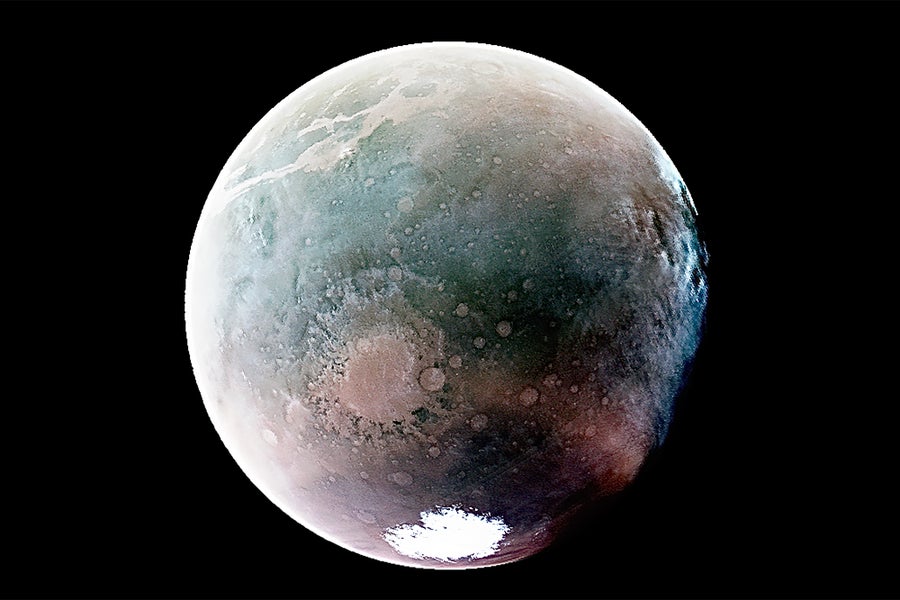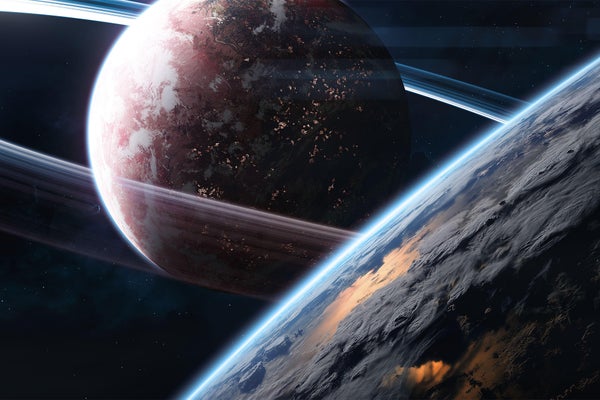When I write or give public talks about exoplanets—alien worlds orbiting other stars—the most common question I’m asked is, “When will we find another Earth?”
当我撰写关于系外行星--环绕其他恒星运行的外星世界--的文章或发表公开演讲时,我最常被问到的问题是:"我们什么时候才能找到另一个地球?
It’s a good question. As we’re learning, space is filled with a great many wildly differing worlds, and it’s natural to wonder whether there’s an Earth 2.0 out there or whether they’re all truly, well, alien.
这是个好问题。正如我们所了解到的那样,太空中充满了许多千差万别的世界,我们自然会怀疑是否存在地球 2.0,或者它们是否真的都是外星人。
Our galaxy, the Milky Way, harbors hundreds of billions of stars. A recent census of local stars shows that planets occur at least as often as stars, so there could be trillions of planets in our galaxy alone. Of course, realistically, that doesn’t mean every star has a planet; rather some don’t have any, and others have teeming solar systems.
我们的银河系蕴藏着数千亿颗恒星。最近对本地恒星的普查显示,行星出现的频率至少与恒星相同,因此仅银河系中就可能有数万亿颗行星。当然,现实中,这并不意味着每颗恒星都有行星;相反,有些恒星没有行星,而有些恒星则有大量的太阳系。
Exoplanets come in a dizzying variety of types, some incredibly bizarre: planets as big as Jupiter but skimming so close to their host stars’ surfaces that the scorching heat strips away their atmosphere, turning them into mega comets; worlds bigger than Earth but smaller than Neptune, which are the most common kind of exoplanet seen despite our solar system’s lack of one; and planets where it might rain molten iron. Oddballs abound.
系外行星的种类繁多,令人眼花缭乱,其中不乏令人难以置信的怪异现象:大如木星的行星,却如此接近宿主恒星的表面,以至于炙热的高温带走了它们的大气层,使它们变成了巨型彗星;比地球大但比海王星小的世界,尽管我们的太阳系没有系外行星,但这却是最常见的系外行星;还有可能会下熔铁雨的行星。古怪的行星比比皆是。
And, yes, the list includes many Earth-size worlds. Of the 5,500 or so exoplanets found to date, about 100 are close in size to our home planet. But there’s more to Earth than just its size.
是的,这份名单包括了许多地球大小的世界。在迄今为止发现的约 5500 颗系外行星中,约有 100 颗与我们的地球大小相近。但地球的魅力不仅仅在于它的大小。
If you’re looking for an exact replica—say, with Earth’s size, mass and composition, as well as breathable air and drinkable water—those odds look pretty long. Planetary formation involves a lot of random variables that affect how a planet forms and evolves over time. Even small changes can lead to dramatically differentplanetary evolution, and many of these variables interact. For example, a planet a little bit warmer than Earth—perhaps orbiting a hotter star or closer to a cooler star—could wind up with a runaway greenhouse effect that boils its oceans and eventually heats its desiccated surface to the melting point of lead. There but for the grace of Venus go we.
如果你正在寻找一个完全相同的复制品--比如说,具有地球的大小、质量和成分,以及可呼吸的空气和可饮用的水--这种可能性看起来非常大。行星的形成涉及许多随机变量,这些变量会影响行星的形成和随时间的演变。即使是微小的变化也会导致行星演化的巨大差异,而且这些变量中的很多都是相互影响的。例如,一颗比地球温度稍高的行星--它可能环绕着一颗温度较高的恒星运行,或者更靠近一颗温度较低的恒星--可能会产生失控的温室效应,使其海洋沸腾,最终将其干燥的表面加热到铅的熔点。金星的恩典在那里等着我们。
As we’re experiencing now, even a relatively small change in atmospheric carbon dioxide can have profound effects on the global environment. This factor alone probably won’t make Earth uninhabitable, but the changes are happening rapidly enough that they’re making things decidedly uncomfortable.
正如我们现在所经历的,即使大气中二氧化碳的变化相对较小,也会对全球环境产生深远的影响。这一因素本身可能不会让地球变得不适合人类居住,但这种变化发生得太快了,以至于让人感觉很不舒服。
On top of that, Earth hasn’t always been Earth-like as we understand it. For two billion years our world lacked what we would consider a breathable atmosphere, and it was only through a catastrophic environmental change that free oxygen became available. It’s also possible that our planet went through at least one period of total glaciation, the hypothetical “snowball Earth” era. Although this last idea is controversial, it’s clear that for long periods Earth was not the clement home we now know.
除此之外,地球并不总是我们所理解的地球。在 20 亿年的时间里,我们的世界缺乏我们认为可以呼吸的大气层,只有通过一场灾难性的环境变化,我们才获得了自由氧气。我们的星球也有可能至少经历过一次冰川期,即假想的 "雪球地球 "时代。虽然最后一个观点还存在争议,但很显然,地球在很长一段时间里并不是我们现在所知道的美好家园。
Moreover, there’s growing consensus in the scientific community around the idea that Mars was once more habitable than its current thin atmosphere and dry surface would imply. Several billion years ago it might have been more like Earth is now than Earth was then. Perhaps even Venus—now a decently convincing version of hell—could have once been habitable.
此外,科学界越来越一致地认为,火星曾经比现在稀薄的大气层和干燥的地表更适合居住。在几十亿年前,火星可能更像现在的地球,而不是当时的地球。甚至金星--现在是一个令人信服的地狱版本--也可能曾经适宜居住。

NASA’s MAVEN (Mars Atmosphere and Volatile EvolutioN) mission acquired stunning views of Mars in ultraviolet images taken at points along our neighboring planet’s orbit around the Sun.
美国国家航空航天局(NASA)的MAVEN(火星大气与挥发物演化)任务在火星绕太阳轨道沿线各点拍摄的紫外线图像中获得了火星的迷人景色。NASA/LASP/CU Boulder
Even the very notion of habitability is fuzzier than you might think. There are icy moons in the outer solar system that have oceans of water under their frozen surfaces, as well as other conditions potentially conducive for life. Eternal darkness in temperatures just above freezing may not sound like Eden, but it could be paradise for life that evolved there.
就连 "宜居性 "这个概念本身也比你想象的要模糊。外太阳系有一些冰冷的卫星,其冰冻的表面下有海洋,还有其他可能有利于生命的条件。温度刚刚超过冰点的永恒黑暗听起来可能不像伊甸园,但对于在那里进化的生命来说,它可能是天堂。
All this is to say we don’t think we’ve found a planet orbiting another star that’s just like Earth. For one thing, we don’t know enough about the atmospheres and chemical compositions of these worlds to say whether they’re Earth-like. Of the 100 Earth-size exoplanets mentioned earlier, only three also have roughly Earth’s mass and receive about the same amount of light and heat from their host star. Three. That’s a tiny fraction, but to be fair, our current discovery methods are better at finding big, hot planets. Small, mild ones like our own are far tougher to spot.
综上所述,我们并不认为我们已经找到了一颗环绕另一颗恒星运行的、与地球一样的行星。首先,我们对这些世界的大气层和化学成分还不够了解,无法判断它们是否与地球相似。在前面提到的100颗地球大小的系外行星中,只有3颗质量与地球差不多,从它们的主恒星接收的光和热也差不多。三颗这只是很小的一部分,但公平地说,我们目前的发现方法更擅长于发现又大又热的行星。像我们这样小而温和的行星就很难发现了。
But methods improve all the time, and we may not have to wait too much longer for astronomers to announce they’ve found an Earth analogue among the stars. When we do, what then?
但是方法在不断改进,我们可能不用等太久,天文学家就会宣布他们在恒星中发现了地球的类似物。如果真的找到了,又该怎么办呢?
It’s not like we can go there. There’s no USS Enterprise we can use to warp over to the nearest Earth 2.0, and without faster-than-light travel, it would be a long trip. Even the fastest spaceship ever launched would take the better part of a millennium to get to the nearest star system, Proxima Centauri (which does actually host an Earth-size planet that might—might—be within our range of acceptability). Better pack a lunch.
我们又不能去那里我们没有企业号宇宙飞船可以用来翘曲到最近的地球 2.0,如果没有超光速旅行,那将是一次漫长的旅行。即使是史上最快的宇宙飞船,也要花上大半个千年的时间才能到达最近的恒星系统--比邻半人马座(那里确实有一颗地球大小的行星,也许--也许--在我们的接受范围之内)。最好带上午餐。
So many sci-fi movies tell us we need to evacuate Earth that it’s a trope. This idea is far more fi than sci, though; humanity increases its number by more than 70 million people every year. You’d need to launch 2,000 SpaceX Starships every day just to keep up with that increase, even ignoring the less than helpful travel times. Easing population pressure via interstellar immigration is a nonstarter.
许多科幻电影都告诉我们,我们需要撤离地球,这已经成了一个套路。不过,这个想法远比科幻更科幻;人类每年增加 7000 多万人。即使不考虑不太有用的旅行时间,每天也需要发射 2000 艘 SpaceX 星际飞船才能跟上这一增长速度。通过星际移民来缓解人口压力是不可能的。
Establishing a settlement is a tall order, too. We don’t even really know how to do this in low-Earth orbit, on the moon or on Mars. We’re a long, long way from being able to set up shop on an alien Earth even if we could easily get to one.
建立定居点也是一项艰巨的任务。我们甚至不知道如何在低地球轨道、月球或火星上建立定居点。即使我们可以很容易地到达外星地球,但要在外星地球上开店,我们还有很长很长的路要走。
When I’m asked about Earth 2.0, the implicit part of the question is whether we can travel to it and live there. Simply put, we can’t. So why look if we can’t go?
当我被问及地球 2.0 时,问题的隐含部分就是我们能否前往地球并在那里生活。简单地说,我们不能。既然不能去,为什么还要看呢?
Because—to paraphrase a possibly apocryphal answer to a similar question—it’s probably there. We look because we want to know.
因为--套用一个可能是天方夜谭的类似问题的答案--它很可能就在那里。我们看是因为我们想知道。
Searching for an Earth clone isn’t the point of exoplanetary science—except it really kind of is. Scientifically speaking, we look for other planets because we want to understand how they form, how conditions change their physical properties, and how they differ from or mirror the planets in our own solar system.
寻找克隆地球并不是系外行星科学的重点--但这确实是重点之一。从科学角度讲,我们之所以寻找其他行星,是因为我们想了解它们是如何形成的,它们的物理特性是如何在各种条件下发生变化的,以及它们与我们太阳系中的行星有何不同或相似之处。
But emotionally, we yearn to see another pale blue dot somewhere out in the depths of space, to know that somewhere, sometime, conditions were just so to replicate—or at least resemble—those with which we are so familiar. Certainly, just knowing it’s out there would profoundly change the way we see the universe and our place in it. Such a discovery would also help us understand Earth better.
但在情感上,我们渴望在太空深处的某个地方看到另一个苍白的蓝点,渴望知道在某个地方、某个时间,条件是如此地复制--或者至少与我们如此熟悉的条件相似。当然,只要知道它就在那里,就会深刻地改变我们看待宇宙的方式和我们在宇宙中的位置。这样的发现也会帮助我们更好地了解地球。
It may also help us answer the most fundamental question humans have ever had: How did we get here? For millennia this question has inspired speculation, myth, religion and philosophy. With a distant blue-white world hovering in the eyepiece, it becomes science. Knowable. And then we can, perhaps, indulge ourselves further. If we find another habitable world, we can dare to crack open the door for the next Big Question: Are we alone?
它还可以帮助我们回答人类有史以来最根本的问题:我们是怎么来到这里的?千百年来,这个问题一直激发着人们的猜测、神话、宗教和哲学。随着一个遥远的蓝白色世界在目镜中盘旋,它变成了科学。可知。然后,我们也许就可以进一步放纵自己了。如果我们发现了另一个宜居世界,我们就可以大胆地为下一个大问题打开大门:我们是孤独的吗?
This is an opinion and analysis article, and the views expressed by the author or authors are not necessarily those of Scientific American.
本文为观点和分析文章,作者表达的观点不代表《科学美国人》的观点。

